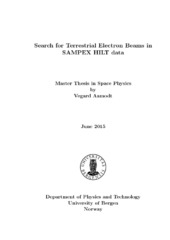| dc.contributor.author | Aamodt, Vegard | eng |
| dc.date.accessioned | 2015-08-24T15:00:17Z | |
| dc.date.available | 2015-08-24T15:00:17Z | |
| dc.date.issued | 2015-06-01 | |
| dc.date.submitted | 2015-06-01 | eng |
| dc.identifier.uri | https://hdl.handle.net/1956/10357 | |
| dc.description.abstract | The Solar Anomalous and Magnetospheric Particle Explorer (SAMPEX) was a low polar orbiting satellite operating from 1992 to 2012. The goal of this master project has been to see if Terrestrial Electron Beams (TEBs), ~20 ms bursts of electrons, were detected by the Heavy Ion Large Telescope (HILT) instrument on SAMPEX. After 1996 this instrument was switched to a mode where electrons in excess of 1 MeV were detectable, with a time resolution of 20 ms and a geometric factor of 60 cm^2sr. The time resolution and the relatively large geometric factor are reasons why we use HILT on SAMPEX. TEBs are secondary relativistic electrons generated by Terrestrial Gamma-ray Flashes (TGFs) via Compton scattering and pair production. These electrons gyrate along geomagnetic field lines out to space. It is possible for satellites to detect such electrons several thousands of kilometers from where they originate, if the satellite passes through the actual field line at the right moment. To distinguish real signals from variations in background noise, Poisson distribution is used to search for TEBs in HILT data for 2012. More than 300 TEB candidates, significant above background radiation, are observed. For all TEB candidates, the magnetic field lines are traced down to 45 km altitude. At the foot points we have searched for lightning using data from the World Wide Lightning Location Network (WWLLN). A null hypothesis has been performed to test if the lightning activity is random or correlated to the TEB candidates. We have done a modeling analysis of how many TEBs SAMPEX is expected to observe, compared to Fermi results. The probability of observing more than one TEB per year by SAMPEX, is estimated to be ~9.8%. Mostly all of the ~300 observed TEB candidates in 2012 are most likely something else than TEBs. Cosmic ray showers are thought to generate TEB mimic signals. One possible TEB has been found. Both in space and time, this event is correlated to two WWLLN detected lightning strokes. | en_US |
| dc.format.extent | 17700079 bytes | eng |
| dc.format.mimetype | application/pdf | eng |
| dc.language.iso | eng | eng |
| dc.publisher | The University of Bergen | en_US |
| dc.rights | Copyright the Author. All rights reserved | eng |
| dc.subject | Terristriske gammaglimt | Nob |
| dc.subject | Elektrondeteksjon | Nob |
| dc.subject | Satellitter | Nob |
| dc.subject | Elektronstråler | Nob |
| dc.subject | lightning | eng |
| dc.subject | Terrestrial Electron Beams | eng |
| dc.subject | TEB | eng |
| dc.title | Search for Terrestrial Electron Beams in SAMPEX HILT data | en_US |
| dc.type | Master thesis | |
| dc.description.degree | Master i Fysikk | en_US |
| dc.description.localcode | MAMN-PHYS | |
| dc.description.localcode | PHYS399 | |
| dc.subject.realfagstermer | http://data.ub.uio.no/realfagstermer/c000566 | |
| dc.subject.realfagstermer | http://data.ub.uio.no/realfagstermer/c031411 | |
| dc.subject.realfagstermer | http://data.ub.uio.no/realfagstermer/c006730 | |
| dc.subject.realfagstermer | http://data.ub.uio.no/realfagstermer/c005838 | |
| dc.subject.nus | 752199 | eng |
| fs.subjectcode | PHYS399 | |
